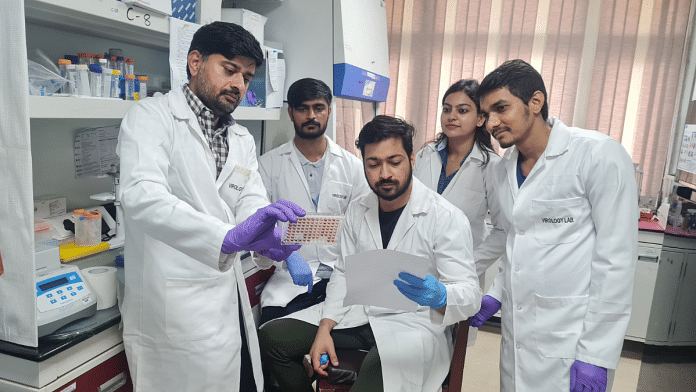Bengaluru: Scientists from the Indian Institute of Science and Research (IISER), Bhopal, have made an important discovery that could have a huge impact on the treatment of the potentially life-threatening disease AIDS.
They have identified a type of ribonucleic acid or RNA molecule that helps copy the genetic material of HIV-1 — the most common type of the human immunodeficiency virus (HIV) — allowing it to multiply in the human body. HIV is the virus that attacks the body’s immune system and eventually leads to AIDS.
They have also developed a protein molecule that can reduce the multiplication of the HIV virus.
According to the scientists’ study and peer-reviewed findings that were published in the Science Advances journal on 6 September, a circular RNA molecule called ciTRAN plays a key role in aiding HIV.
RNA is as important as DNA and performs a host of tasks, from carrying genetic information to helping in the production of protein. There are two main types of RNA — straight-chain and closed-loop. The closed-loop RNAs are called circular RNAs, and they change their behaviour when the body’s immune system is activated when it is infected or inflamed.
Circular RNAs are important indicators of a virus’s transmission systems. Yet the role they play when the body is infected with HIV was not clear — until now. The findings are the first to associate circular RNAs with HIV replication, identifying a crucial link in how the disease spreads through the body, and identifying a specific type of circRNA’s role in the process.
The scientists also identified how the HIV virus hijacks ciTRAN’s RNA code, and disables a key protein in the RNA molecule that is supposed to prevent HIV replication. Additionally, they found that only HIV molecules, with the accessory protein Vpr, are capable of hacking into ciTRAN RNA molecules.
“There have been several studies on cancer and circular RNAs, but none on HIV replication. Ours is the first,” lead researcher Ajit Chande told ThePrint.
In a press release issued on 25 September, IISER Director Gobardhan Das said the discovery “opens up new lines of investigations and may provide new leads for host-directed treatments”.
What scientists found
Chande and his team used a novel method called nanopore direct RNA sequencing or circDR-Seq to isolate and analyse circular RNA molecules infected with HIV-1.
Since linear RNAs are 99 percent more common than circular RNAs in specialised immune system cells called T-cells, the team iteratively removed different types of linear RNAs from the T-cell so that they were finally left with circular RNAs that they could study.
Then the mix was further refined by increasing the concentration of the circular RNAs to better differentiate them and identify the ones involved in HIV viral replication.
Through the use of CRISPR-Cas9, they found that ciTRAN RNA molecules helped in the multiplication of the HIV virus. The HIV virus hijacks the ciTRAN RNA molecule and promptly disables the stop switch for HIV replication — a protein called SRSF1, whose job it is to stop HIV from replicating.
“Basically, ciTRAN is used by the HIV virus to promote its genetic information and synthesise its viral proteins,” Chande explained, adding that CiTRAN also stops an inhibitory protein called SRSF1 from doing its job and preventing the replication of the HIV virus.
The scientists also identified an accessory protein — a type of protein that is inside HIV cells — which needs to be present for a virus to hijack ciTRAN, called the Vpr protein.
The study is important for further research in HIV virus treatments. The scientists found that while HIV could disable SRSF1, synthetic molecules that mimic the structure of the SRSF1 molecule can be used to do SRSF1’s job of suppressing HIV replication.
“Modelled on the SRSF1 protein in our body, we generated a small protein molecule that can reduce the multiplication of HIV virus in the context of ciTRAN,” Chande told ThePrint.
(Edited by Uttara Ramaswamy)
Also Read: HIV, polio, now Covid — How CMC Vellore has been leading healthcare & research for 121 yrs



